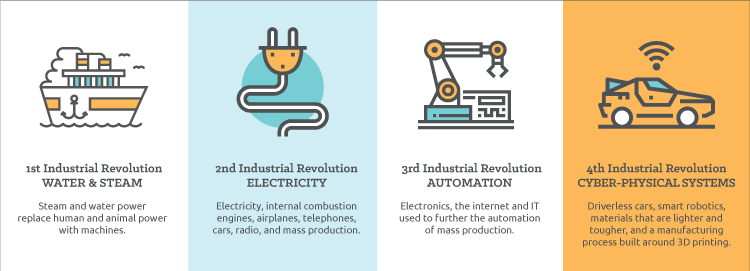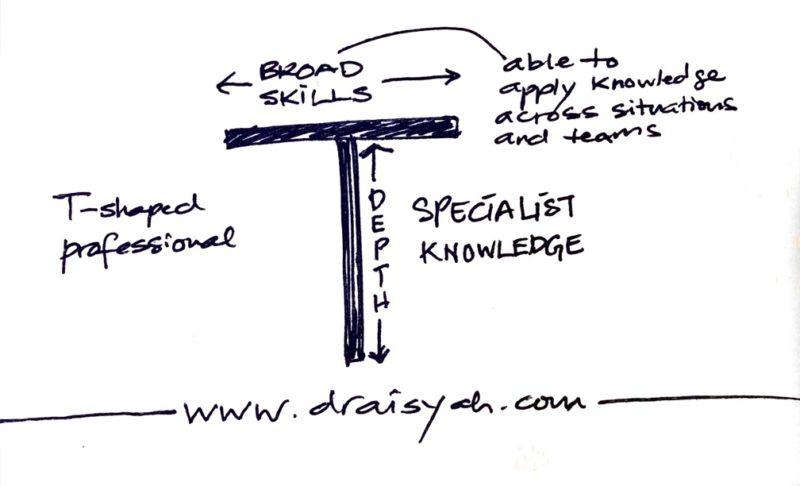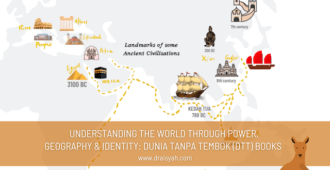This is Part II of the earlier post on the recent talk given by Dato’ Dr. Afifi Al-Akiti in UKM. As we are at the cusp of the 4IR, perhaps we could ask a couple of questions e.g. How am I going to be a part of the Fourth Industrial Revolution? If my expertise is not in science and technology, e.g. in Arts and Social Sciences, how can it be relevant to this period?
Dato’ Dr. Afifi Al-Akiti delivered an hour and a half-long talk; here I list out 3 takeaways that could help you get some idea where we are heading and how not to be left behind in the 4IR…
First takeaway: How does the 4IR come about?
Rather than starting with a ‘what’ question, Dato’ Dr. Afifi began his talk, aptly, with history. A brief history of pre-industrial revolution (the medieval period) before he went to give succinct labels to the four industrial revolutions – each in one word.
1IR: Mechanical – 2IR: Electricity –
3IR: Computers – 4IR: Digital Revolution.
In many instances, I can’t imagine presenting without slides. Let alone presenting about the 4IR without showing some visuals. Thus, I find Dato’ Dr. Afifi’s succinct way of putting a simple label to each industrial revolution effective and easy to remember.
For visual learners, the following figure shows the progression of the IRs.

Briefly, the first industrial revolution is mechanical revolution i.e. the shift in production from hands to machines, from families or communities to factories. Mass production of textiles and steam-powered machines took place around 1780 – 1850. The first IR mainly occurred in the UK.
The spread of the first industrial revolution, from Britain to the rest of the world
As you can see from the map below, the spread of technological advances from Britain. Then, to the rest of the Europe (and the States & Japan) where it took several decades. The speed and extent of the IR depended on the socio-economic and political outlook of the countries; in many instances on individuals, inventors and businessmen.
During this period, a culture of creativity and innovations flourished. Many ‘movers and shakers’ of inventions and innovations came from outside their own specialised domains (see the names below).
A strong driving factor in the first IR lies in high demands of manufactured goods. To this end, good availability of raw materials (e.g. cotton, iron, steel) via trade and colonisation (e.g. East India Company, Dutch East India Company). These are some factors that facilitated the spread of the IRs.

The second industrial revolution is driven by electricity. It is characterised by petroleum and chemical industries (chemicals extracted from petroleum e.g. petroleum jelly). Thanks to the electrical power, massive factories and manufacturing capacity were possible, unlike in the first industrial revolution. Also factories became less reliance on animal and people.
Thomas Edison and Henry Ford are perhaps two key people of this period starting from 1870 up until the First World War in 1918.
The third IR is the advent of computers and its information technology that led to widespread automation, on which the fourth is establishing itself. In the talk, Dato’ Dr. Afifi kept it simple, as we are still defining the 4IR, as the digital or internet revolution.
Which bring us to the common thread shared by all the four IRs…
Second takeaway: Making life easier in the 4IR
As highlighted by Dato’ Dr. Afifi, each IR period brings forth technological advancement and innovations (bid’ah hasanah) that change our life.* Each also has major drawbacks e.g. pollutions, but each makes our life easier.
Each period is marked by inventors and innovators. Richard Arkwright, Michael Faraday, Thomas Edison, Steve Jobs**, Mark Zuckerberg and Elon Musk.
And Prof. Muhammad Yunus included. He provides an alternative way, a know-how, via social business. It opens avenues for the poor help themselves. To gain self-agency, dignity and have a place in the industrialised world of the rich and middle-class.
These inventors, innovators and distruptors created and built systems that (perhaps) have never been invented before. They had a vision. Of a system, e.g. mobile devices, apps, electric cars, that makes life easier. Better. More convenient.
Where can Islamic studies come into 4IR? Something that Dato’ Dr. Afifi asked us to really think. If we’re not yet in this picture… It’s not too late, then he urged, “Ask yourself what do you do for the Ummah in the context of the 4IR? And in Islamic studies?” To make full use of our precious time on earth, he encouraged us to learn the skills in this era, e.g. how to do coding or DIY apps, or collaborate with others e.g. computer scientists.
Tabung Baitumal Sarawak – Jejak Asnaf app
Dato’ Dr. Afifi mentioned about Muslims being a minority in Sarawak, similar to the UK.
The Tabung Baitumal Sarawak (Majlis Islam Sarawak) learns to be lean, mean and very efficient – that they are self-sufficient with little help from the federal government.
Dato’ Dr. Afifi Al-Akiti
Dato’ Dr. Afifi shared that Baitulmal in Sarawak created an app ‘Jejak Asnaf’ to help speed up the process of identify the poor and needy who are eligible for tithe (zakat) from the Baitulmal.
I’ve seen the promo video of the app. The app features seem quite useful – maps, ability to take photos for reporting. I’m looking forward to see how far can it help streamlining the process to reach out to the people in need. If successful, its use could be extended to other States in Malaysia.
And I’m hopeful that such initiative would receive continuing support for further version improvements.
Third takeaway: Read around the subjects
“We have become too specialised,” Dato’ Dr. Afifi lamented.
When he asked his students why they took up Islamic Studies? To become like you… To be an ulama’… yet one common answer he received was because they wanted to become a Mufti.
At this point, Dato’ Dr. Afifi quoted a hadith by Prophet Muhammad SAW,
Actions are according to intentions, and everyone will get what was intended…
Related by Bukhari and Muslim (40hadithnawawi.com)
He further stressed that one should aim to become “… those who are most beneficial to the people…”. And to purify our intention in what we decide to pursue.
To have such ambition is good, but may put oneself in a box. Thus, he or she may unable to relate to others.
How can you become a good Mufti if you don’t read around the subject?
A student aspiring to become a Mufti may become so specialised in, e.g. Fiqh, that other related disciplines in Islamic studies are studied superficially or at worst, ignored.
Dato’ Dr. Afifi implored everyone and students to read around (and outside) their own specialisation – to become a Renaissance Man.
Imam Ghazali is an exemplary example. Another is Leonardo da Vinci, since he lived and thrived during the Renaissance period. Both excelled in many different areas. In today’s term, a multi-talented man or woman.
… once you have read around your subject, and then you become a Mufti, I really do hope that you read the Economist.
Dato’ Dr. Afifi Al-Akiti
Furthermore, Dato’ Dr. Afifi emphasised the importance of learning Arabic, English and other languages. The points he made were directed specifically to scholars and students in Islamic Studies, but I think is applicable to scholars in other departments and specialisations too.
In sum, I surmise that in the 4IR, it’s best to become a Mufti with high empathy, understanding and being quite well informed. Such Mufti will be able to relate and respond to various human conditions, for instance in social and economic aspects of life, before issuing a fatwa (a ruling). A fatwa that will affect the Ummah.
Three more points…
Talks come in different walks. There is a talk that makes you happier – if you’re sad; a motivational talk. Another type makes you feel enlightened that you’ve learned something new. And that’s it.
And then, there is another type is a talk that inspires you to take action. Points made in the talk are akin to many windows of opportunities. Windows to learning and understanding. That the points lead and motivate you to open the windows to learning a wider worldview and to learning deeper about Self.
In the informative talk, Dato’ Dr. Afifi has shared many good points – I watched and/or listened 3-4 times to it, yet I’m afraid not all points can be noted here. In addition, as I’m not an expert in Islamic Studies, I shall refrain myself from commenting and writing matters that I have no or little knowledge. Therefore, I urge you readers to find some time to listen to Dato’ Dr. Afifi’s talk.
My first point, on “reading around the subject”
As we are approaching the 4IR, skills and competencies of the future workforce change accordingly as we see more and more reliance on Big Data, machine & deep learning, IoT and automation. Why more reliance? Because tech adoption promotes business growth, augments existing jobs and leads to new jobs creation.
Invariably, technology will keep improving. As a result, training and upskilling are vital in any learning organisation that views its workforce as an asset, not a liability. Staff left untrained presents a creeping liability.
For a professional working in the 4IR, one needs to keep learning. Instil the good habit of reading. Read around and outside your own expertise. To gain better understanding of the world and how it works. And how you can leverage on these technologies to benefit you and your communities.
My second point is about “T” and “I”-shaped professionals
Dato’ Dr. Afifi’s talk on reading around the subject, reminds me of T-shaped skills, a concept introduced more than 2 decades ago. I’ve heard this many times in leadership workshops I’d involved. The vertical stroke represents the focus area or specialisation of a professional; whereas the horizontal stroke represents the broad skills that facilitate collaborative effort across specialisations.

Yet many professionals prefer to remain in their own area, or the “I-shaped” skills. This is the main basis of academic career promotions in universities.
On the other hand, professionals having T-shaped skills tend to foster diverse perspectives from different specialisations would often lead to exceptional and innovative outcomes.
Both skill types are essential in any organisation. The disposition of T-shaped professionals appears more suitable to address the multi-disciplinary nature of the workforce in the 4IR, hence will be highly valued.
Where 1+1 leads to a sum of 3.
Third point, on the Industrial Revolutions
That what has been presented and written here, and in other sources may just be a tiny weeny glimpse into what took place in 16th century onwards.
From my readings around the IRs, I become more aware of other concurrent countries or civilisations. For instance, in China during the Song dynasty (8th – 13th century). That they may already those technological advances or innovations in place but never have seen the light of the day – as one version history may get highlighted more than others.
Often the previous civilisation or “the teachers” are forgotten or conveniently left out as one basks in the glory and trumpets one’s successes.
Yet human civilisations rarely exist in silo.
An attempt to delve into the Renaissance and ensuing periods is beyond the scope of my blog here. I do find history and ancient civilisations very interesting; but I’m not a historian 😉 I do encourage you to dig deeper, if this post has piqued your interest.
An afterthought…
A general pattern I notice here, as we move from one industrial revolution to the next, we are becoming less and less dependent on manual labour (animal and human). The world’s industrial players are increasingly relying on technology. On algorithms and automation. On energy sources. Renewable or non-renewable.
A piece of technology can’t run without energy.
So whether we like it or not, the 4IR is on its way. In education, the effort to inculcate:
1) Adab: no equivalence in English.
Watch Tan Sri Syed Muhammad Naquib al-Attas‘s talk and also mentioned in Prof. Kanwar’s talk.
2) higher order thinking (HOTS) skills, according to Bloom’s Taxonomy
in our future nation builders, makers, artists and thinkers – can no longer be delayed or ignored.
In other words, in the 4IR, the power and thus paradigm have dramatically shifted – the question is… what are you waiting for?
Till then! =)
*If I may add, each IR is not without dramatic and extensive social and economic impact to mankind and the planet. For starter, you may learn more here.
** A big Apple fan can’t miss the opportunity to include Steve Jobs. Apple products have transformed the way I work. Sorry, I’m biased.




Cool, thanks for sharing. watching the video itself now. Very amazed that the good Dr Afifi is able to talk about technological advances with injections of the deen and history.
You’re welcome, Hafiz. Yes, Dato’ Dr Afifi gave an interesting talk, highly relevant to the progress of today’s ummah. Please spread the word!